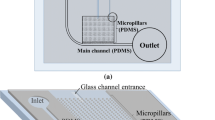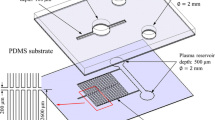Abstract
Separation of blood plasma or serum from blood is essential for accurate analysis. Conventional blood separation requires instrumentation, reagents, and large sample volumes, limiting this process to laboratory environments with trained personnel. Full implementation of effective blood separation and analysis on microliter sample volumes for point of care (POC) diagnostics has proven extremely challenging resulting in a growing market demand, with common challenges such as expensive device fabrication processes or devices being comprised of materials which are not easily disposable. We developed a membrane-based wicking microfluidic device which is made using a simple fabrication process. This device uses a unique 3D flow channel geometry, fabricated in a polycaprolactone-filled glass microfiber membrane, to efficiently separate microliter sample volumes of blood. Colorimetric assay chemistries were integrated to demonstrate utility of these devices in POC diagnostics. The devices are capable of separating both fresh and anticoagulant-treated blood at microscale sample volumes (<15.0 μL). Modifications to the base device are also reported herein which increased sample volume capacity and separation efficiency. Integrated colorimetric assay enabled semi-quantitative detection of conjugated bilirubin in real blood samples (1.0–1.5 mg/dL). These blood separation devices, fabricated on polycaprolactone-filled glass microfiber, enabled effective blood plasma (anticoagulant-treated blood) and serum (fresh blood) separation with microscale sample volumes. Sample volume capacity and separation efficiency are customizable for specific applications and devices can be integrated with downstream assay chemistries to develop complete POC devices that offer blood separation and diagnostics at the same time on a single membrane.
Graphical abstract







Similar content being viewed by others
Data availability
Not applicable
Abbreviations
- EDTA-Na2 :
-
Ethylenediaminetetraacetic acid disodium salt dehydrate
- GMF:
-
Glass microfiber
- HCl:
-
Hydrochloric acid
- H2SO4 :
-
Sulfuric acid
- NEED:
-
N-(1-Naphthyl) ethylenediamine dihydrochloride
- ORE:
-
Oxygen radical exposure
- PBS:
-
Phosphate-buffered saline
- PCL:
-
Polycaprolactone
- POC:
-
Point of care
- SEM:
-
Scanning electron microscope
References
Blood Tests | National Heart, Lung, and Blood Institute (NHLBI) 2020. https://www.nhlbi.nih.gov/health-topics/blood-tests. Accessed 28 Apr 2020.
Dao Q, Krishnaswamy P, Kazanegra R, Harrison A, Amirnovin R, Lenert L, et al. Utility of B-type natriuretic peptide in the diagnosis of congestive heart failure in an urgent-care setting. J Am Coll Cardiol. 2001;37:379–85. https://doi.org/10.1016/s0735-1097(00)01156-6.
Smith RA, Cokkinides V, Eyre HJ. American Cancer Society guidelines for the early detection of cancer, 2006. CA Cancer J Clin. 2006;56:11–25. https://doi.org/10.3322/canjclin.56.1.11.
Mitchell PS, Parkin RK, Kroh EM, Fritz BR, Wyman SK, Pogosova-Agadjanyan EL, et al. Circulating microRNAs as stable blood-based markers for cancer detection. Proc Natl Acad Sci. 2008;105:10513–8. https://doi.org/10.1073/pnas.0804549105.
Bennett CM, Guo M, Dharmage SC. HbA1c as a screening tool for detection of type 2 diabetes: a systematic review. Diabet Med. 2007;24:333–43. https://doi.org/10.1111/j.1464-5491.2007.02106.x.
Lieberman DA, Harford WV, Ahnen DJ, Provenzale D, Sontag SJ, Schnell TG, et al. One-time screening for colorectal cancer with combined fecal occult-blood testing and examination of the distal colon. 2009. https://doi.org/10.1056/NEJMoa010328.
Morrison LK, Harrison A, Krishnaswamy P, Kazanegra R, Clopton P, Maisel A. Utility of a rapid B-natriuretic peptide assay in differentiating congestive heart failure from lung disease in patients presenting with dyspnea. J Am Coll Cardiol. 2002;39:202–9. https://doi.org/10.1016/S0735-1097(01)01744-2.
Prabowo MH, Chatchen S, Rijiravanich P, Limkittikul K, Surareungchai W. Dengue NS1 detection in pediatric serum using microfluidic paper-based analytical devices. Anal Bioanal Chem. 2020;412:2915–25. https://doi.org/10.1007/s00216-020-02527-6.
Anker P, Mulcahy H, Qi Chen X, Stroun M. Detection of circulating tumour DNA in the blood (plasma/serum) of cancer patients. Cancer Metastasis Rev. 1999;18:65–73. https://doi.org/10.1023/A:1006260319913.
Jahr S, Hentze H, Englisch S, Hardt D, Fackelmayer FO, Hesch R-D, et al. DNA fragments in the blood plasma of cancer patients: quantitations and evidence for their origin from apoptotic and necrotic cells. Cancer Res. 2001;61:1659–65.
Hrubec TC, Whichard JM, Larsen CT, Pierson FW. Plasma versus serum: specific differences in biochemical analyte values. J Avian Med Surg. 2002;16:101–5.
Plasma and Serum Preparation - US 2020. https://www.thermofisher.com/us/en/home/references/protocols/cell-and-tissue-analysis/elisa-protocol/elisa-sample-preparation-protocols/plasma-and-serum-preparation.html. Accessed 28 Apr 2020.
Tanaka Y, Noda Y, Kobayashi M, Yamada Y, Hirao K. Microvolume blood-sampling device with low hemolysis and high consistent yield of serum components. Clin Chem. 2001;47:1829–35. https://doi.org/10.1093/clinchem/47.10.1829.
Amasia M, Madou M. Large-volume centrifugal microfluidic device for blood plasma separation. Bioanalysis. 2010;2:1701–10. https://doi.org/10.4155/bio.10.140.
Yang S, Ündar A, Zahn JD. A microfluidic device for continuous, real time blood plasma separation. Lab Chip. 2006;6:871–80. https://doi.org/10.1039/B516401J.
Pugia MJ, Blankenstein G, Peters R-P, Profitt JA, Kadel K, Willms T, et al. Microfluidic tool box as technology platform for hand-held diagnostics. Clin Chem. 2005;51:1923–32. https://doi.org/10.1373/clinchem.2005.052498.
Honda N, Lindberg U, Andersson P, Hoffmann S, Takei H. Simultaneous multiple immunoassays in a compact disc–shaped microfluidic device based on centrifugal force. Clin Chem. 2005;51:1955–61. https://doi.org/10.1373/clinchem.2005.053348.
Karimi S, Mojaddam M, Majidi S, Mehrdel P, Farré-Lladós J, Casals-Terré J. Numerical and experimental analysis of a high-throughput blood plasma separator for point-of-care applications. Anal Bioanal Chem. 2021. https://doi.org/10.1007/s00216-021-03190-1.
Azimi S, Farahani A, Docoslis A, Vahdatifar S. Developing an integrated microfluidic and miniaturized electrochemical biosensor for point of care determination of glucose in human plasma samples. Anal Bioanal Chem. 2021;413:1441–52. https://doi.org/10.1007/s00216-020-03108-3.
Li B, Qi J, Fu L, Han J, Choo J, de Mello AJ, et al. Integrated hand-powered centrifugation and paper-based diagnosis with blood-in/answer-out capabilities. Biosens Bioelectron. 2020;165:112282. https://doi.org/10.1016/j.bios.2020.112282.
Kim D, Kim S, Kim S. An innovative blood plasma separation method for a paper-based analytical device using chitosan functionalization. Analyst. 2020;145:5491–9. https://doi.org/10.1039/D0AN00500B.
Son JH, Lee SH, Hong S, Park S, Lee J, Dickey AM, et al. Hemolysis-free blood plasma separation. Lab Chip. 2014;14:2287–92. https://doi.org/10.1039/C4LC00149D.
Dimov IK, Basabe-Desmonts L, Garcia-Cordero JL, Ross BM, Ricco AJ, Lee LP. Stand-alone self-powered integrated microfluidic blood analysis system (SIMBAS). Lab Chip. 2011;11:845–50. https://doi.org/10.1039/C0LC00403K.
Heist CA, Bandara GC, Bemis DJ, Pommerenck JC, Remcho VT. New paper-based microfluidic tools for the analysis of blood serum protein and creatinine built via aerosolized deposition of polycaprolactone. Anal Methods. 2018;10:2994–3000. https://doi.org/10.1039/C8AY00981C.
Bandara GC, Heist CA, Remcho VT. Patterned polycaprolactone-filled glass microfiber microfluidic devices for total protein content analysis. Talanta. 2018;176:589–94. https://doi.org/10.1016/j.talanta.2017.08.031.
Songjaroen T, Dungchai W, Chailapakul O, Henry SC. Laiwattanapaisal W. Blood separation on microfluidic paper-based analytical devices. Lab Chip. 2012;12:3392–8. https://doi.org/10.1039/C2LC21299D.
Ng AHC, Wheeler AR. Next-generation microfluidic point-of-care diagnostics. Clin Chem. 2015;61:1233–4. https://doi.org/10.1373/clinchem.2015.240226.
Yu Z, Kastenmüller G, He Y, Belcredi P, Möller G, Prehn C, et al. Differences between human plasma and serum metabolite profiles. PLoS One. 2011;6:e21230. https://doi.org/10.1371/journal.pone.0021230.
Bond WW, Petersen NJ, Favero MS, Schable CA, Murphy BL, Berquist KR, et al. Evaluation of a finger prick blood collection method for the seroepidemiology of hepatitis B. Bull World Health Organ. 1978;56:791–6.
With TK. The diazo reaction of bilirubin. measurements in pure aqueous solutions and in solutions containing human serum. Acta Physiol Scand. 1945;10:181–92. https://doi.org/10.1111/j.1748-1716.1945.tb00303.x.
Modrovich IE. Stable single liquid reagent for determination of direct bilirubin in sera and method of forming same. US5112769A. 1992.
Qi A, Yeo L, Friend J, Ho J. The extraction of liquid, protein molecules and yeast cells from paper through surface acoustic wave atomization. Lab Chip. 2009:470–6. https://doi.org/10.1039/B915833B.
Bandara GC, Heist CA, Remcho VT. Chromatographic separation and visual detection on wicking microfluidic devices: quantitation of Cu2+ in surface, ground, and drinking water. Anal Chem. 2018;90:2594–600. https://doi.org/10.1021/acs.analchem.7b04087.
Yang X, Forouzan O, Brown PT, Shevkoplyas SS. Integrated separation of blood plasma from whole blood for microfluidic paper-based analytical devices. Lab Chip. 2012;12:274–80. https://doi.org/10.1039/C1LC20803A.
Wnek GE, Carr ME, Simpson DG, Bowlin GL. Electrospinning of nanofiber fibrinogen structures. Nano Lett. 2003;3:213–6. https://doi.org/10.1021/nl025866c.
Bandara GC, Remcho VT. Oxygen radical-driven surface modification of polycaprolactone-filled glass microfiber media: probing the surface chemistry of wicking microfluidic devices. Surf Interface Anal. 2019;51:840–8. https://doi.org/10.1002/sia.6658.
Kremer MH. Electrospray deposition of discrete nanoparticles: studies on pulsed-field electrospray and analytical applications. 2019.
Brooks T, Keevil CW. A simple artificial urine for the growth of urinary pathogens. Lett Appl Microbiol. 1997;24:203–6. https://doi.org/10.1046/j.1472-765X.1997.00378.x.
Bilissis PK, Speer RJ. A stable bilirubin standard. Clin Chem. 1963;9:552–3. https://doi.org/10.1093/clinchem/9.5.552.
Ünlü B, Küme T, Emek M, Örmen M, Doğan Y, Şişman AR, et al. Effect of blood cell subtypes lysis on routine biochemical tests. J Med Biochem. 2018;37:67–77. https://doi.org/10.1515/jomb-2017-0044.
Nilghaz A, Shen W. Low-cost blood plasma separation method using salt functionalized paper. RSC Adv. 2015;5:53172–9. https://doi.org/10.1039/C5RA01468A.
Rand RN, di Pasqua A. A new diazo method for the determination of bilirubin. Clin Chem. 1962;8:570–8. https://doi.org/10.1093/clinchem/8.6.570.
ImageJ 2020. https://imagej.nih.gov/ij/. Accessed 28 Apr 2020.
Acknowledgements
The authors acknowledge Christopher A. Heist and Breeanna Zirkle for their assistance with assay chemistry optimization, and Rylie Grace Tiffin for her assistance with device fabrication. We also thank Perstorp (Warrington, UK) for donating us PCL samples.
Code availability
Not applicable
Author information
Authors and Affiliations
Contributions
Gayan C. Bandara: conceptualization, investigation, methodology, data collection, data curation, writing, editing. Linus J. Unitan: Investigation, data collection, data curation, methodology, writing, editing. Matthew H. Kremer: investigation, methodology, SEM imaging, writing, editing. Owen T. Shellhammer: investigation, data collection. Shay Bracha: supervision, blood sample collection, methodology. Vincent T. Remcho: conceptualization, methodology, supervision, writing, editing.
Corresponding author
Ethics declarations
Animal welfare
All applicable international, national, and/or institutional guidelines for the care and use of animals were followed. Canine blood samples used in this work were obtained from excess left over after routine diagnostic procedures. As this blood was not collected specifically for this study, this work was exempted from IACUC approval.
Conflict of interest
The authors declare no competing interests.
Additional information
Publisher’s note
Springer Nature remains neutral with regard to jurisdictional claims in published maps and institutional affiliations.
Supplementary information
ESM 1
(DOCX 5336 kb)
Rights and permissions
About this article
Cite this article
Bandara, G.C., Unitan, L.J., Kremer, M.H. et al. Wicking microfluidic approach to separate blood plasma from whole blood to facilitate downstream assays. Anal Bioanal Chem 413, 4511–4520 (2021). https://doi.org/10.1007/s00216-021-03420-6
Received:
Revised:
Accepted:
Published:
Issue Date:
DOI: https://doi.org/10.1007/s00216-021-03420-6




